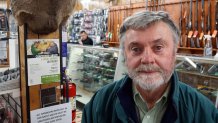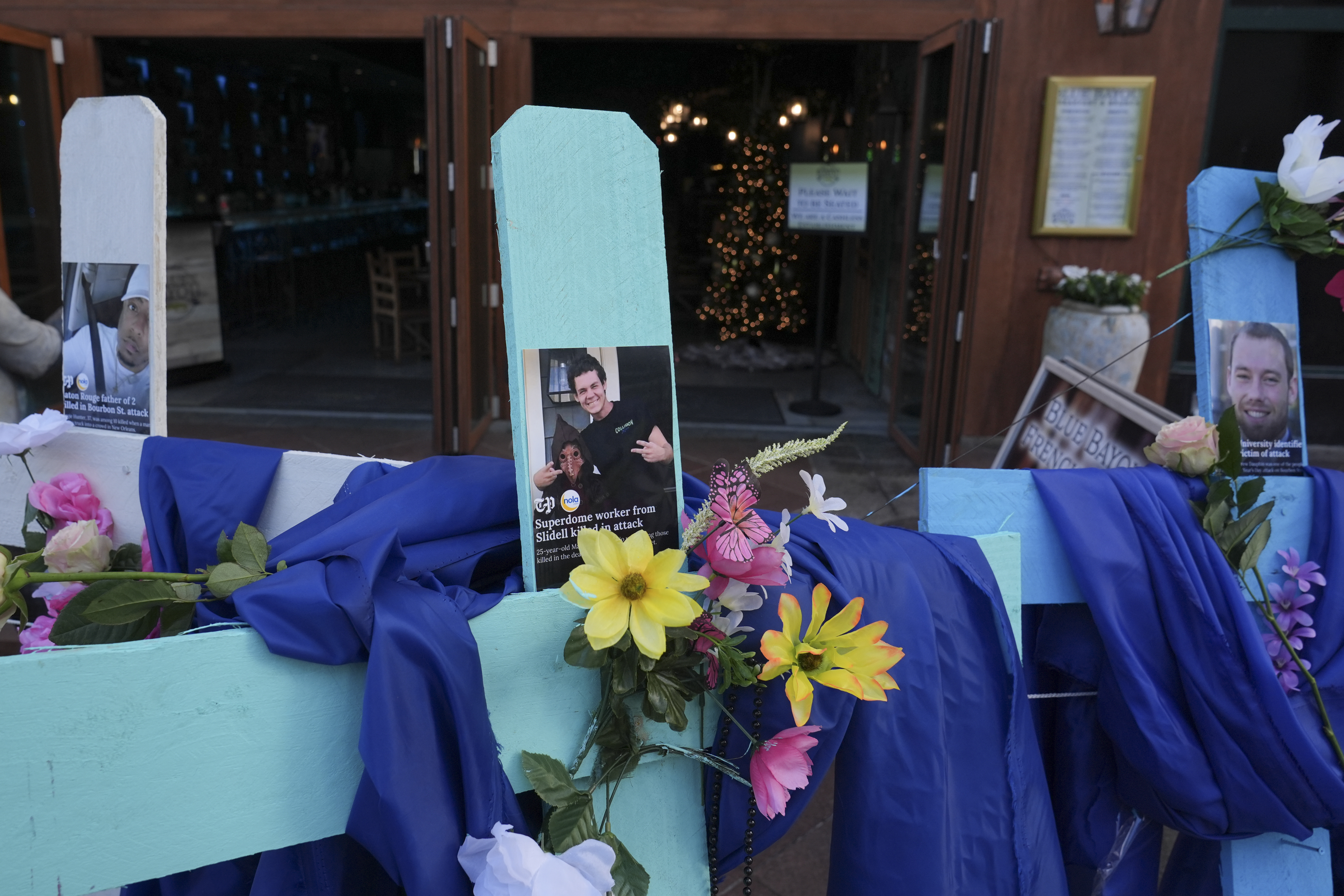Suicide has followed Amanda Barner since she was a child. She grew up knowing that her great-grandmother hanged herself when her mother was just 9 years old. At the age of 14, Barner’s friend died by suicide. From there, the list grew to include other relatives, a former student, people from her community and, eventually, her son.
Four years after Stephen’s death, the pain remains. She doesn’t mind talking about her son — it’s when strangers ask if she has any children that Barner gets tongue-tied.
[[416965863,300,600,L]]
"If you say you only have one, then it's like I'm betraying Stephen," she said. "If I say I have two, and they ask questions and then I eventually say, 'My older son is deceased,' the conversation stops. They don't want to talk to you anymore."
Like the rest of his family, Stephen was a gun enthusiast and avid outdoorsman. His paternal grandfather taught him to shoot and hunt at an early age, a pastime shared by almost every family member, including his mother on occasion. He knew about gun safety and was diligent with his own firearms. He also suffered from depression and anxiety.
Still, his mother didn’t think the combination was lethal.
"When we did have an inkling that this might be a possibility, I never thought it would be a gun," Barner said of her son’s suicide. "He was very respectful. He took care of them. He knew how to handle them."
Suicide is the second-leading cause of death in the United States among people between the ages of 10 and 34, according to the Centers for Disease Control and Prevention. In 2015, more than 44,000 people died by suicide, and half used a firearm. While women are more likely to attempt suicide by overdosing, the most common method of death by suicide among men is with a firearm, accounting for roughly 80 percent of all gun-related suicide deaths.
The distinction is an important one — people who use firearms have an 85 percent completion rate compared to people who use other methods, according to the CDC. By contrast, drug overdoses — the leading suicide method — is fatal only 3 percent of the time.
Because attempts using firearms are so fatal, public health experts at Harvard University developed a messaging campaign aimed at what they call "means reduction." The concept is simple — prevent suicides by reducing access to a firearm while in crisis.
"You don’t want attempts to be easy," explained Cathy Barber, director of the Means Matter campaign. "You want to arm people with the knowledge that they can get through a period like this."
U.S. & World
News from around the country and around the globe
On the weekend before his death, Stephen went hunting with friends. He returned to his father’s home in Langhorne and left his hunting rifle in the garage to be cleaned another day. Wednesday night, Stephen turned the firearm his mother purchased for him as an 18th birthday present on himself.
"He went to work for his father and the next day I got a call that he had shot himself," Barner said.
Looking back on that week, something she does often, nothing seemed out of the ordinary. "He was always a little depressed and ... not really sure of himself," she said, noting that her son’s fragility was part of his normal.
"I don’t know what happened … a fight with somebody, an argument. I don’t know if it was just the way he was feeling. There was no note," Barner said.

Suicidal thoughts are frequently transient and can pass within a matter of minutes, according to experts. A study conducted by the Harvard School of Public Health found that 48 percent of suicide attempt survivors conceived of the idea 10 minutes before the act. If guns can be taken out of the immediate equation, a person’s likelihood of surviving increases exponentially, Barber said.
Reducing access to deadly means is not a new concept. The United Kingdom implemented a similar tactic in 1958 after health officials observed high rates of suicide via gas inhalation. At the time, the majority of domestic gas used for heating and cooking was derived from coal and contained between 10 to 20 percent carbon monoxide. In order to reduce suicide rates, officials replaced gas appliances with a natural alternative that contained little or no carbon monoxide. Suicide rates dropped and did not spike again.
"That can be very counterintuitive to people — they will say someone can always find other means, but most people are not staying acutely suicidal for long," Barber said.
Current research suggests a strong correlation between suicide and access to guns. More than 12 case studies by the National Institutes of Health found that people who died by suicide were more likely to live in homes with guns. These findings are consistent with what experts gleaned from a self-reporting tool given to young patients at the Children’s Hospital of Philadelphia’s emergency department. Approximately 20 percent of adolescents with suicidal thoughts had guns in the home or access to firearms within a 24-hour period.

"Ideation and firearms access is not a good combination, but one does not always lead to the other," said Tita Atte, a Drexel University behavioral health researcher who helped develop the screening tool.
The real problem, as explained by Dr. Joel Fein, attending physician at CHOP’s emergency department, is the lethal nature of guns.
"We know that if you have access to a firearm and you want to hurt yourself, it’s almost a done deal. It’s very hard to not kill yourself if you have a gun and you want to do it," he said.
Stephen had a history of mental health problems. Bullied for a slight stutter and diagnosed with Attention Deficit Disorder (ADD), he developed a habit of cutting himself at an early age. His parents enrolled him in therapy and kept close contact with teachers and nearby friends. Some days were worse than others. Moving to a new school proved stressful for the quiet teen, but he found release through track and field.
On his worst days, he escaped by jogging around the neighborhood or disappearing to a local abandoned quarry. Barner worried about those sullen jaunts, but her open relationship with her eldest child quieted any real panic.
Still, Barner took her son twice to the Central Bucks Crisis Center at Doylestown Hospital. Both times he was released after convincing doctors that he was not suicidal.
"There was nothing I could do," Barner said. "He was smart enough to say the right thing and get out."
After graduation, Stephen visited a military field office and soon after started basic training. He hoped to be assigned to the explosives unit, but failed to pass the test by just one percentage point. Instead, Stephen enrolled at Bucks County Community College with hopes of one day re-enlisting as an officer.
Barner took all of this as a sign that things were improving, or, at the very least, not worsening.
The day before he died, 20-year-old Stephen visited his dentist for a broken tooth. He also paid his dad money that he owed him. While the latter might signal some kind of plan to attempt suicide, Barner didn’t notice anything out of the ordinary. After all, Stephen had spent the previous weekend in the mountains with a local family.
"He could have done something at that time," Barner said. "What happened four days later that when he got home, he gave in to the decision to go through with it?"
That shortened timeframe is crucial to understanding suicide and reducing the risk of death, according to Barber. For her, minimizing access to guns is not about the Second Amendment. It’s about risk assessment.
With this in mind, the Harvard researcher forged an unlikely partnership with a New Hampshire gun store owner.

Ralph Demicco is now retired, but shooting remains a central part of his life. The 70-year-old co-chair of the New Hampshire Firearms Safety Coalition never thought much about suicide. It was something that happened to other people. Yet Demicco, who studied sociology in college, always felt a responsibility to his community. Safety and care were part of a social contract necessary to maintain peace.
One day in 2009, Demicco got a call from an acquaintance at Dartmouth College who informed him that three people had purchased guns at his store in the same week and used those firearms to kill themselves.
"It was astonishing," he said. "We always had very strict sales requirements, and I always told my employees they were under no obligation to sell."
In a small town like Hooksett, three concurrent suicides do not go unnoticed. Demicco started questioning his clerks and reviewing surveillance video from security cameras. The transactions all checked out. He couldn’t understand how three suicides could be traced back to Riley’s Sport Shop.
Demicco reached out to colleagues at other gun stores and shooting ranges and was surprised to learn none of them had any kind of suicide prevention training or resources on hand. He complained to his friend at Dartmouth and together they approached Barber.
From that meeting eventually came the Gun Shop Project, a suicide prevention and awareness campaign now implemented throughout 21 states with more in the works. It teaches members of the gun community to watch for buyers who might be at risk and promotes safe storage of guns and ammunition at home.
Retailers and their employees are trained to identify signs of distress and keep suicide prevention literature on hand for people in immediate danger to themselves or others.
"I don’t know any responsible firearm owner who shrugs their shoulders and says suicide is a personal matter," Demicco said.
This kind of messaging is crucial to making headway within the gun community. Barber described it as a "friends don’t let friends drive drunk" approach, complete with an emphasis on community and personal responsibility.
"It’s not a firearms issue. It’s a suicide issue," Demicco said.
While no local retailers have adopted the Gun Shop Project model, nearby states such as New York and Maryland do have similar programs in place.
Regina Schneider, who owns Atlantic Guns in Rockville and Silver Spring, helped spearhead regional efforts by enlisting the help of the Maryland Firearms License Association.
Like Demicco, Schneider is committed to means reduction but not restriction. She is not in favor of preventing people with mental health concerns from purchasing firearms, but does worry for those in immediate crisis.
"If a person is truly unable to be stable, the ownership of a gun is not appropriate," she said. "That is an unfortunate reality for some individuals."
A similar effort has been launched by the National Shooting Sports Foundation, which teamed up with the American Foundation for Suicide Prevention last year for Project 2025, an initiative that aims to reduce the suicide rate by 20 percent.
"If you don't trust the messenger, you don't trust the message," Barber said. "Instead of bringing in an anti-gun message, why not work with gun owners as part of this solution? There's a lot of commitment to safety, to reducing unintentional shootings and to protecting the family."



